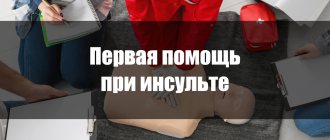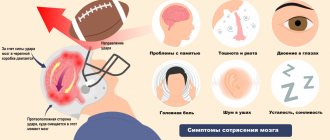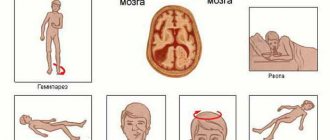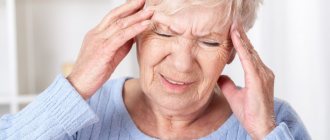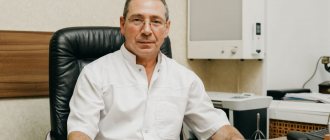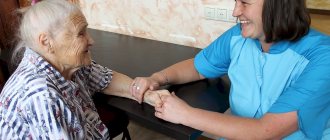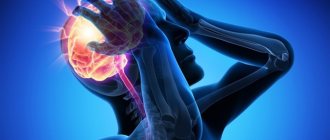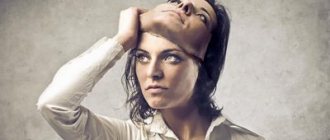A stroke is an acutely developing deviation of cerebral circulation, which is caused by spasm, sudden rupture, blockage of cerebral vessels by a thrombus or embolus, leading to disruption of the functioning or integrity of cerebral vessels, significant disruption of the functioning of brain tissue or hemorrhage in them. As a result of such disorders, the affected area of the brain suffers from oxygen starvation and its tissues are subject to destruction and death. In the future, such changes lead to disability, and in severe cases, death can occur.
Stroke and its types
A stroke is a brain injury in which blood vessels rupture or become blocked. Because of this, cells die, since they are not supplied with blood and oxygen. If a person is not treated promptly, brain damage can become irreversible, ultimately leading to death.
A stroke can be left-sided or right-sided. In the first case, pain appears in the right half of the body, in the second - in the left.
There are two types of stroke:
- Hemorrhagic
. The reason for the development of this form is the rupture of a blood vessel located in the brain. This occurs due to high BP (blood pressure). Cerebral hemorrhage is often fatal. Such a stroke occurs suddenly - the patient feels a sharp pain in the head, similar to a blow, then the skin of the face turns red, the victim breathes noisily and hoarsely. Frequent companions of such a stroke are lethargy and vomiting. - Ischemic
. This form develops due to blockage of a blood vessel. Such a stroke does not occur instantly; it can be recognized by warning signs. There is no loss of consciousness in this form, but the victim feels sick. Sometimes you feel better, but this effect is temporary.
Stroke is divided into three degrees of severity. If it is mild, the patient usually recovers after undergoing a course of treatment and rehabilitation. Moderate and severe stroke leads to death in 20% of cases, and up to 80% of victims become disabled.
Causes and risk factors
Impaired blood flow to the brain is the main cause of stroke. It is because of this that rupture or blockage of blood vessels occurs. Blockage can occur due to the following reasons:
- thrombosis (often due to atherosclerosis);
- embolism.
Arterial rupture is caused by:
- serious injuries to the skull and brain;
- arterial hypertension;
- aneurysm and other pathologies of arterial walls.
There are risk factors that predispose to stroke:
The child's organ system is formed after conception has occurred, but sometimes a hole forms between the cavities of the heart valves and the process is disrupted. Read more in the article: “VSD in a newborn.”
| Risk factor | Description |
| Age and gender | With age, the risk of developing the disease increases (usually it develops after 40-45 years). Stroke is more common in men |
| Heart diseases | Arrhythmias, heart failure and other pathologies of the cardiovascular system increase the risk of stroke |
| Hypertension | High blood pressure increases the risk of stroke by 4 times if it exceeds 160/95 mmHg. Art., and 10 times if the readings are above 200/115 mm Hg. Art. |
| Smoking | Men who smoke often develop atherosclerosis, which doubles the risk of stroke |
| Diabetes | The danger of this disease is hypertension and atherosclerosis |
| Oral contraceptives | Drugs that contain high amounts of estrogen (more than 50 mg) can increase the risk of stroke. The combination of taking OCs with high blood pressure and smoking is especially dangerous. |
Causes and factors for the development of a life-threatening condition
Risk factors for heart and vascular disease are similar in many ways. Conventionally, they can be divided into internal and external.
Internal factors are considered:
- diabetes;
- excess body weight;
- gender, since it was found that in men the disease occurs at a slightly earlier age than in women;
- age, since stroke is diagnosed more often in older people;
- heredity, manifested in the presence of hypertension, stroke, or a history of heart attack in close relatives.
External risk factors include:
- Climate and time of year. There is a direct dependence of ischemic stroke on the time of year and weather conditions. The most unfavorable periods are the winter and spring seasons, when there are often sudden changes in weather, large amounts of precipitation, and fluctuating atmospheric pressure and air temperature. It is at such moments that cerebral circulation disorders become more frequent.
- Smoking. An addiction doubles the risk of heart and vascular diseases. Due to the influence of nicotine and many other substances, the composition of the blood changes, blood pressure increases and the heart rate increases. The heart of a smoker makes more contractions than a non-smoker, which leads to premature wear of the heart muscle.
- Inactive lifestyle. Insufficient physical activity has a detrimental effect on human health, leading to obesity, the development of arterial hypertension, diabetes, multiple excess cholesterol levels, which contributes to the formation of cholesterol plaques and blood clots, increasing the risk of circulatory disorders in the brain.
- Regular alcohol consumption. Most often, strokes in young people occurred while they were intoxicated. Systematic consumption of alcohol in large quantities leads to cerebral hemorrhages and cerebral infarction.
- Emotional stress. Overstrain of the nervous system changes the biochemical composition of the blood, the level of electrolytes and leads to oxygen starvation of the vascular wall, which threatens subsequent changes.
Precursors and first signs of stroke in men
To successfully fight the disease, or even prevent it, you need to know about the earliest signs - the warning signs of a stroke. There is reason to be wary if men are bothered by frequent headaches, weakness, dizziness, and nausea. Perhaps these are the first signs of a dangerous disease. In addition, symptoms such as a rare pulse, sweating, blood flow to the face, disturbances in movement and speech, and numbness of the limbs, usually on one side, may occur.
Watery pimples on the body of an adult or child look like cavities raised above the skin level, filled with transparent watery exudate or yellowish ichor. Read more in the article: “watery acne on the body.”
Every man should know the main signs of a stroke, the severity of which can vary. These include:
- Sudden weakness and severe headache.
- Unsteady gait due to lack of coordination of movements.
- Speech disorder.
- Visual and hearing impairments.
- Foggy consciousness.
- Difficulty in perceiving what is happening around.
- Numbness of the right or left side of the body.
- Drooling and difficulty swallowing.
These stroke symptoms are short-lived, mild, and may disappear soon. But it should be remembered that such a mini-attack may soon be followed by a real stroke (mild, moderate or severe). To prevent a recurrent attack, you should consult a doctor immediately after the alarm.
Depending on the location of the damaged area of the brain, dysfunction may be temporary or irreversible. During a stroke, signs such as a rare pulse and pressure changes are observed. The frequency and depth of breathing changes, complete or partial paralysis occurs, and coma is possible. In severe cases, cardiac arrest may occur.
The disease can be recognized by the following signs:
| Sign | Description |
| Violation of facial symmetry | A person suspected of having a stroke should smile (if the disease develops, the smile is asymmetrical) |
| Speech dysfunction | Ask the man to say some simple phrase (with a stroke, a person is not able to pronounce words correctly and form sentences from them) |
| Muscle weakness | If the victim raises both arms in front of him and holds them in this position, one of them will involuntarily drop |
If any of these signs are present (especially if there are several of them at once), the patient should quickly provide first aid, as this can save his life. Before doing this, be sure to call a team of doctors.
How to find out if a man has had a mini-stroke?
It is possible to reliably determine that a person has suffered a micro-stroke only with a special neurological examination, as well as with the help of precise hardware research methods - magnetic resonance imaging, including with a contrast (dye) substance.
Often patients and their relatives ask the doctor “How can I tell if a man has had a mini-stroke?” In addition to a medical examination and MRI diagnostics, there are several tests that you can take at home:
- " Smile ". When you have suffered a micro-stroke, asymmetry of the smile appears or the inability to smile fully on one side.
- " Blind Man's Bluff ". With pathology, one eye will not be completely closed due to impaired innervation of the eyelid muscles.
- " Language ". If you stick out your tongue, its tip will be directed in any direction.
- " Coordination ". If you try to close your eyes and stretch your arms forward, one limb will be tilted or positioned lower.
If the test results differ from the norm, this may be a consequence of a mini-stroke suffered on the legs in men. In this case, it is imperative to consult a neurologist to identify the cause of the pathology and prescribe treatment that will improve the patient’s condition and prevent a recurrent stroke.
Even with proper treatment, a microstroke does not go away without leaving a trace. The “switched off” function of brain cells makes itself felt in the following manifestations.
How can I help?
First aid for hemorrhagic stroke is as follows:
- Do not try to return the person to consciousness on your own, but be sure to monitor so that the tongue does not sink in, which can block the patient’s airway. If you have dentures in your mouth, they must be removed.
- The patient should be laid horizontally, with his head slightly raised and tilted to the side.
- If the attack occurred on the street, the person should not be allowed to go home or take any medications until doctors arrive. The patient can be placed on a bench or even on the grass in a park.
- Remove any items of clothing that may impede breathing, such as a tie or belt, and unbutton your collar to allow fresh air to enter.
- A cold compress should be applied to the patient's head. This could be meat from the freezer, or a bottle of mineral water. Moreover, the compress is applied to the head on the side opposite to the numb one.
- If a stroke is accompanied by vomiting and increased salivation, you need to clean the mouth with a piece of natural tissue.
- If possible, maintain blood circulation in the extremities by covering the patient or applying a heating pad.
- In case of paralysis, it is advisable to rub the limbs with a mixture of vegetable oil and alcohol (2:1) before the doctors arrive. This will alleviate the patient's condition.
The first thing to do is call an ambulance. Provide the patient with a horizontal position, free the neck from clothing. Do not try to give water or food to the patient, this should not be done. Do not give painkillers or other drugs. You can easily massage numb limbs. Don't panic, act calmly until the medical team arrives.
Treatment and care
Stroke treatment is carried out under constant medical supervision in a hospital setting. The injured man is advised to take drugs that improve metabolism in the brain, as well as oxygen therapy and rehabilitation (this includes: massage, physical therapy (PT), physiotherapy).
A man who has suffered from a stroke is prescribed bed rest. In the ischemic form, it lasts up to 5 days (provided there are no progressive symptoms), sometimes this period increases to 2 weeks. In the hemorrhagic form, the patient is on bed rest for 1 to 6 weeks.
During the period of movement restriction, the patient is recommended to tightly bandage his legs or wear compression stockings (these will help avoid blood clots). If this measure does not help, the doctor prescribes heparin injections (intravenous and subcutaneous). After completing hospital treatment, a rehabilitation period begins.
Aftermath and recovery
There are several of the most common consequences of a stroke. Among them:
- Impaired motor activity - paralysis, loss of coordination. Often such complications are observed in a specific area of the body; an arm may fail, muscles on half of the face may weaken, etc.
- Speech disorders, problems with swallowing. This is due to loss of control of the muscles in the mouth and throat.
- Attention problems and short-term memory loss.
- Mental changes. They can be associated both with damage to specific areas of the brain, and with general stress caused by the loss of other functions - movement, speech, vision and others.
- Pain. Such consequences after a stroke are more associated with disruption of signal transmission from the nerve to the brain (phantom pain).
Most often, patients are prescribed rehabilitation, which should restore motor activity and speech.
- Physiotherapy. If there are no contraindications, it can be started already in the first days after a stroke. At first, the movements are not made by the patient himself, but by a rehabilitation therapist who kneads and bends the joints. Gradually the set of exercises becomes more complicated. At a certain stage, special simulators and electrical stimulation of the neuromuscular system can be used.
- Classes with a speech therapist-aphasiologist to restore speech, as well as writing, reading, and counting skills. This therapy necessarily includes homework, and the success of general therapy greatly depends on how the doctor’s advice is followed. For example, constant verbal contact with loved ones at home and in the hospital plays an important role.
Video - Rehabilitation exercises after a stroke
Consequences of microstroke in elderly men
- Hearing and speech impairment.
- Decreased vision.
- Pathology of memory.
- Impaired coordination of movements (gait, fine motor skills of the hands).
- Inability to exercise.
- Marked weakness in the upper and lower extremities.
These are not all the pathological symptoms experienced by patients who have suffered a mini-stroke. At the Doctor Pozvonkov Center for Progressive Medicine, not only a thorough diagnosis of this condition is carried out, but also rehabilitation of patients. Neurologists, physical therapists and rehabilitation specialists at our clinic carry out a full range of therapeutic and rehabilitation measures to reduce and eliminate the consequences of micro-strokes.
Disease prevention measures
Stroke prevention consists of a set of measures to organize a healthy lifestyle:
- control your blood pressure in the morning and evening (optimal systolic (upper) pressure should be in the range of 110-139 mm Hg. If your readings regularly increase, consult your doctor to prescribe medication;
- monitor cholesterol levels, as its high content provokes hardening of blood vessels;
- switch to a healthy diet - reduce salt intake, increase the amount of vegetables and fruits. Make changes to your diet gradually. Avoid snacking on the go and overeating, especially sweets and sausages;
- go in for sports - moderate physical activity (cycling, jogging, gymnastics, walks in the fresh air, swimming, tennis);
- limit your consumption of alcoholic beverages. Without serious consequences for the body, it is permissible to consume 20 grams of pure alcohol per day (this is a bottle of beer, 2 glasses of wine or 50 grams of high-quality vodka);
- undergo annual medical examinations upon reaching 40 years of age (ultrasound of the heart and blood vessels, ECG, biochemical blood test, MRI of the brain).
- eliminate increased psycho-emotional stress and stress. If you cannot completely limit yourself from them, protect the nervous system with plant-based sedatives (Fitosedan, Persen, Tenoten, Afobazol, Herbion, etc.);
- stop smoking.
Chronic stress, snacking on the go, and unfavorable environmental conditions lead to decreased vascular function, which reduces blood supply to the brain. If one of the provoking factors is present, the specialist draws up an individual program for the prevention of hemorrhagic stroke.
Stroke is a fatal disease that affects men over 40 years of age. Smoking and constant stress increase the risk of its development, so you should get rid of all bad habits, be less nervous and be examined at least once a year in a medical facility. Remember that any disease, including stroke, is easier to prevent and prevent than to treat serious complications.
Treatment and prevention
Statistics confirm that stroke treatment in men is more likely to be successful. The likelihood of death is much lower than among women. The treatment process is aimed at restoring and normalizing blood circulation in the affected area of the brain. Thrombolytic therapy, vasodilators and neuroprotectors are used. If a hemorrhagic stroke occurs, surgical intervention will be required to eliminate the hematomas formed after hemorrhage, as well as to reconstruct damaged blood vessels.
The rehabilitation period after a stroke is no less important than the treatment process. A man who has suffered an ischemic stroke must completely change his lifestyle and get rid of many bad habits. It is important to follow a special diet, play sports or exercise therapy, walk in the fresh air more often, completely give up smoking and alcohol, and rest at least 7 hours a day.
Clinical Brain Institute Rating: 3/5 — 6 votes
Share article on social networks
